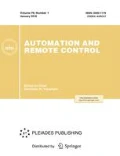Abstract
The classical methods of pattern recognition theory presuppose the independence of elements of a recognizable set. Therefore, even in the case of interrelated objects, the decision on the class of each object is taken independent of the decision on the classes of other objects. At the same time, it is obvious that in this case it is necessary to make consistent decisions on the classes of elements of the interrelated array. In particular, this necessity stems from the prior supposition that neighboring objects of the interrelated array more often belong to one class than to different classes. In many practical problems, such a prior supposition proves to be very natural, enabling one to develop effective recognition algorithms.
Similar content being viewed by others
REFERENCES
Vintsyuk, T.K., Analiz, raspoznavanie i interpretatsiya rechevykh signalov (Analysis, Recognition, and Interpretation of Voice Signals), Kiev: Naukova Dumka, 1987.
Rabiner, L.R., A Tutorial on Hidden Markov Models and Selected Applications in Speech Recognition, Proc. IEEE, 1989, vol. 77, no.2, pp. 257–285.
Mottl, V.V. and Muchnik, I.B., Skrytye markovskie modeli v strukturnom analize signalov (Hidden Markov Models in Structural Analysis of Signals), Moscow: Fizmatlit, 1999.
Kickpatrick, S., Gelatt, C., and Vecci, M., Optimization by Simulated Annealing, Sci., 1983, vol. 220, pp. 671–680.
German, S. and German, D., Stochastic Relaxation, Gibbs Distributions, and the Bayesian Restoration of Images, IEEE Trans. PAMI, 1984, vol. 6, pp. 721–741.
Besag, J.E., On the Statistical Analysis of Dirty Pictures (with Discussions), J. Royal Stat. Soc., 1986, B48, pp. 259–302.
Dvoenko, S.D., Kopylov, A.B., and Mottl, V.V., The Problem of Pattern Recognition in Arrays of Interrelated Objects. Statement of the Problem and Basic Applications, Avtom. Telemekh., 2004, no. 1, pp. 143–158.
Li, R., Optimal'nye otsenki, opredelenie kharakteristik i upravlenie (Optimal Estimates, Definition of Characteristics, and Control), Moscow: Nauka, 1966.
Sage, A.P. and Mels, J.L., Estimation Theory with Application to Communications and Control, New York: McGraw Hill, 1971.
Yarlykov, M.S. and Mironov, M.A., Markovskaya teoriya otsenivaniya sluchainykh protsessov (Markov Theory of Estimation of Random Processes), Moscow: Radio i Svyaz', 1993.
Kemeny, J. and Snell, J., Finite Markov Chains, Princeton: Van Nostrand, 1960.
Feller, W., Introduction to Probability Theory and Its Applications, London: Wiley, 1957.
Fisher, R.A., The Use of Multiple Measurements in Taxonomic Problems, Ann. Eugenics, 1936, vol. 7, pp. 179–188.
Fisher, R.A., The Use of Multiple Measurements in Taxonomic Problems, in Sovremennye problemy kibernetiki (Modern Problems of Cybernetics), Moscow: Znanie, 1979, no. 11, pp. 6–20.
Duda, R. and Hart, P., Pattern Classification and Scene Analysis, New York: Wiley, 1973. Translated under the title Raspoznavanie obrazov i analiz stsen, Moscow: Mir, 1976.
Mottl, V.V., Dvoenko, S.D., Levyant, V.B., and Muchnik, I.B., Pattern Recognition in Spatial Data: A New Method of Seismic Explorations for Oil and Gas in Crystalline Basement Rocks, Proc. 15th ICPR'2000, Barcelona, Sept. 3–8, 2000, vol. 3, pp. 210–213.
Pavlidis, T., Algoritmy mashinnoi grafiki i obrabotki izobrazhenii (Algorithms of Computer Graphics and Image Processing), Moscow: Radio i Svyaz', 1986.
Biologiya (Biology), Yarygin, V.N., Ed., Moscow: Visshaya Shkola, 2001.
Kozinets, B.N., The Recursive Algorithm for Separation of Convex Hulls of Two Sets, in Algoritmy obucheniya raspoznavaniya obrazov (Pattern Recognition Learning Algorithms), Vapnik, V.N., Ed., Moscow: Sovetskoe Radio, 1973, pp. 43–50.
Vapnik, V.N. and Chervonenkis, A.Ya., Teoriya raspoznavaniya obrazov (statisticheskie problemy obucheniya) (Pattern Recognition Theory: Statistical Problems of Learning), Moscow: Nauka, 1974.
Cortes, C. and Vapnik, V., Support-Vector Networks, Machine Learning, 1995, vol. 20, no.3, pp. 273–297.
Vapnik, V.N., Statistical Learning Theory, New York: Wiley, 1998.
Bishop, C.M. and Tipping, M.E., Variational Relevance Vector Machines, Proc. 16th Conf. On Uncertainty in Artificial Intelligence, 2000, pp. 46–53.
Bishop, C.M. and Winn, J.M., Non-linear Bayesian Image Modeling, Proc. 6th ECCV' 2000, Dublin, 2000, vol. 1, pp. 3–17.
Corduneanu, A. and Bishop, C.M., Variational Bayesian Model Selection for Mixture Distributions, in Artificial Intelligence and Statistics, Jaakkola, T. and Richardson, T., Eds., 2001, pp. 27–34.
Author information
Authors and Affiliations
Additional information
__________
Translated from Avtomatika i Telemekhanika, No. 12, 2005, pp. 162–176.
Original Russian Text Copyright © 2005 by Dvoenko, Kopylov, Mottl.
Rights and permissions
About this article
Cite this article
Dvoenko, S.D., Kopylov, A.V. & Mottl, V.V. A Problem of Pattern Recognition in Arrays of Interrelated Objects. Recognition Algorithm. Autom Remote Control 66, 2019–2032 (2005). https://doi.org/10.1007/s10513-005-0232-9
Received:
Issue Date:
DOI: https://doi.org/10.1007/s10513-005-0232-9




